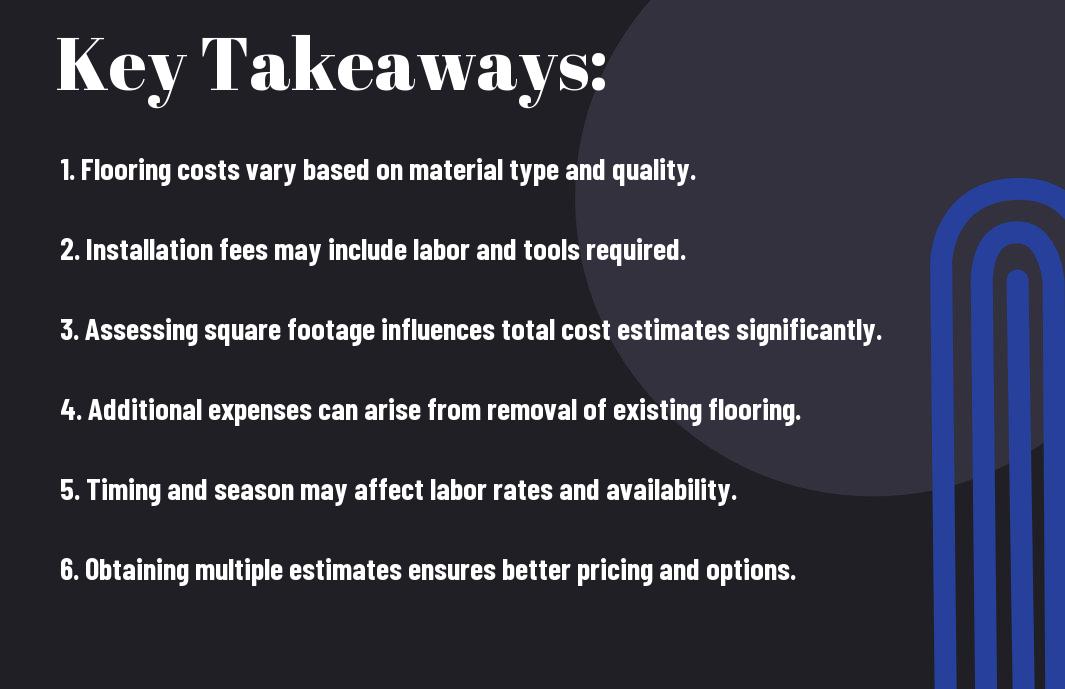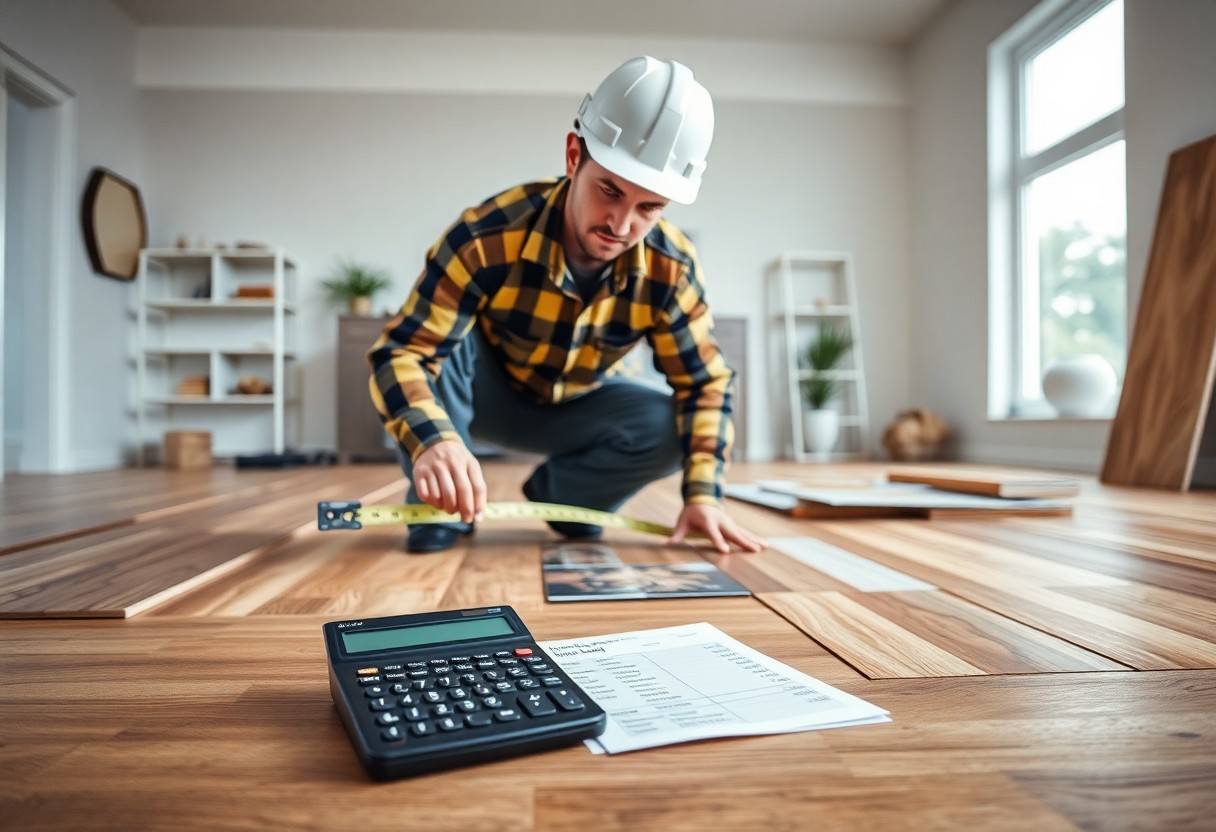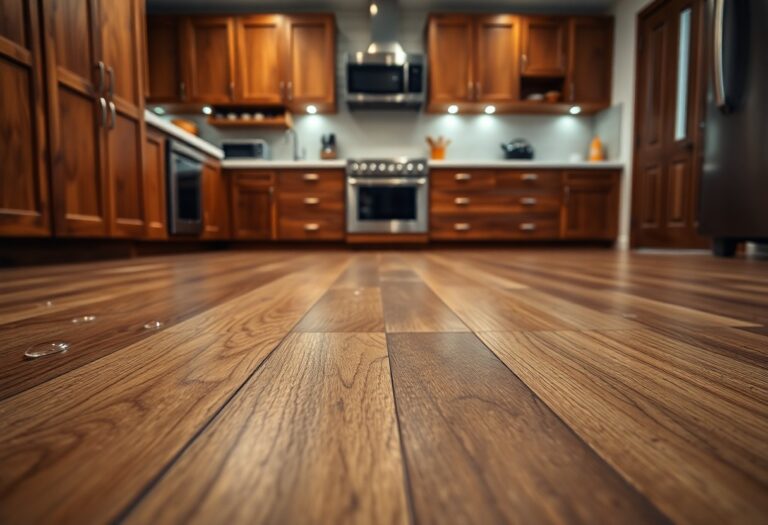Just when you think you’re ready to transform your space, the question of flooring installation costs and estimates can feel overwhelming. Understanding the various factors influencing pricing, from materials to labor, is key to making informed decisions for your project. In this comprehensive guide, you will learn everything you need to know to navigate your flooring installation expenses, ensuring that your investment aligns with your budget and design aspirations.


Understanding Flooring Types
While exploring flooring options, it’s important to understand the various types available, each offering unique benefits and costs. Consider the following:
- Hardwood
- Laminate
- Tile
- Carpet
- Vinyl
This knowledge will help you make informed decisions that suit your preferences and budget.
| Flooring Type | Estimated Cost per Square Foot |
| Hardwood | $6 – $12 |
| Laminate | $1 – $5 |
| Tile | $1 – $20 |
| Carpet | $2 – $5 |
| Vinyl | $1 – $3 |
Hardwood Flooring
For many homeowners, hardwood flooring is a sought-after option due to its natural beauty and durability. It can enhance the aesthetic of any space and often increases property value.
Laminate Flooring
At a lower price point, laminate flooring mimics the appearance of hardwood or tile while providing easy maintenance. It is an excellent choice for budget-conscious homeowners seeking style without breaking the bank.
And with a wide range of designs and textures available, laminate can seamlessly fit into any home decor, making it a versatile option. You’ll appreciate its resistance to scratches and dents, adding value to your investment.
Tile Flooring
Any discussion about flooring would be incomplete without mentioning tile flooring. This durable option is perfect for wet areas like kitchens and bathrooms due to its water resistance.
Hence, tile comes in various materials, including ceramic and porcelain, allowing you to choose a style that complements your design vision while ensuring longevity and ease of cleaning.
Carpet
An inviting choice for bedrooms and living areas, carpeting offers warmth and comfort underfoot. It’s an excellent sound insulator and can enhance the coziness of any room.
Understanding the different materials available for carpet can help you select one that meets your lifestyle needs, whether you have pets or small children, ensuring a suitable and durable flooring solution for your home.
Factors Influencing Installation Costs
The cost of flooring installation can vary significantly due to various factors that you should consider. These include:
- Type of flooring material
- Size of the area to be covered
- Geographical location
- Complexity of the installation
- Preparation of the subfloor
Any of these elements can impact your total installation costs, so it’s vital to evaluate them carefully.
Material Costs
Influencing your overall budget, the choice of flooring material plays a pivotal role in installation costs. Different materials, such as hardwood, laminate, vinyl, or tile, come with varying price points that can have a substantial impact on your final expenses.
Labor Costs
Across the board, labor costs can vary widely based on your location, the complexity of the job, and the contractor you choose. High-quality, experienced professionals may charge more, but their expertise can greatly influence the durability and appearance of your flooring.
In fact, hiring seasoned installers often results in fewer mistakes and a smoother overall process, which could save you money in the long run. Ensuring you invest wisely in labor can lead to high-quality work that enhances the longevity of your flooring.
Additional Expenses
By taking into account other expenses, such as underlayment, old flooring removal, and necessary repairs, you can avoid any budget surprises. These costs can add up quickly but are often vital to achieving a successful flooring installation.
Material considerations, from glue to baseboards, can also contribute to additional expenses. Ensuring you have a comprehensive understanding of all potential costs will help you budget appropriately and choose options that align with your financial goals.

Average Cost Estimates
Once again, understanding average cost estimates for flooring installation can help you budget effectively. Costs can vary widely depending on the material you choose, the complexity of the installation, and additional preparation needed for your space. On average, you might find prices ranging from $3 to $10 per square foot, though high-end materials could increase that significantly. Being aware of these estimates allows you to make informed decisions when selecting the perfect flooring for your home.
Per Square Foot Costs
Behind every flooring project lies the significant factor of per square foot costs, which includes both materials and labor. The average price you might encounter typically falls between $3 and $15 per square foot, depending on the type of flooring you select. For example, vinyl and laminate options tend to be more budget-friendly, while hardwood and natural stone tend to push the price higher. Knowing these costs will provide a clearer picture of your total investment.
Regional Price Variations
An important aspect to consider is regional price variations that can impact your flooring costs. Variations may arise from local labor rates, availability of materials, and regional demand for specific flooring types. As a result, you may find that hiring professionals or purchasing materials is more expensive in urban areas compared to rural locations.
Another point to note is that these regional price variations can significantly affect your overall budget. In areas with a higher cost of living, you may observe installation costs increase by as much as 20% or more compared to less populated regions. Additionally, keep in mind that delivery fees for materials can also fluctuate based on your location. So, as you plan your flooring project, it’s vital to factor in these regional differences to avoid unexpected expenses.
DIY vs. Professional Installation
Many homeowners face the choice between DIY flooring installation and hiring professionals. Understanding the pros and cons of each option will help you determine the best course of action for your project and budget. While DIY can save you money, professional installation often ensures a quality finish and can save you time and hassle.
Pros and Cons of DIY
The following table outlines the pros and cons of DIY flooring installation:
| Pros | Cons |
|---|---|
| Cost-effective | Time-consuming |
| Full control over the process | Requires skill and knowledge |
| Flexible timing | Potential for mistakes |
| Opportunity for learning | Physical labor involved |
| Ability to customize | Limited tools and equipment |
When to Hire Professionals
To ensure a seamless flooring installation, you should consider hiring professionals when your project involves complex patterns, large areas, or specialized materials. Their expertise can save you time, prevent mistakes, and deliver quality results that can enhance your home’s aesthetic appeal.
Hence, if you find yourself overwhelmed by the thought of measuring, cutting, and installing new flooring, or if you’re dealing with unique features like stairs or awkward corners, hiring professionals is a wise choice. They bring experience, advanced tools, and a guarantee of craftsmanship that can make the investment worthwhile, ensuring your flooring looks impeccable for years to come.
Budgeting for Flooring Installation
Your budget for flooring installation is vital in determining what materials and styles you can afford. To ensure you stay on track, consider all associated costs such as materials, labor, and any additional preparations needed for your space. Having a clear budget helps you make informed decisions and avoid any unexpected financial strain.
Creating a Flooring Budget
For a successful flooring budget, begin by researching the costs of different materials, like hardwood, laminate, or tile. Factor in installation expenses, as well as additional items such as underlayment and trim. Set realistic spending limits for each aspect of your project to keep your finances organized and manageable.
Financing Options
Beside setting a budget, it’s wise to explore financing options that can ease the burden of upfront costs. Various choices include personal loans, store credit, and installment plans, all designed to help you manage payments over time.
Understanding your financing options is key to making flooring installation affordable. Personal loans can provide a lump sum for your project with fixed repayment terms. Alternatively, some flooring retailers offer store credit or financing plans that allow you to pay in installments. Be sure to compare interest rates and terms to find the option that best fits your budget and financial situation.
Getting Quotes and Estimates
Keep in mind that obtaining multiple quotes from different flooring contractors will give you a clearer idea of the market rates and help you make an informed decision regarding your flooring project.
How to Request Estimates
About requesting estimates, it’s vital to be clear and specific when contacting potential flooring professionals. Provide details about your project, including the type of flooring, the square footage of the area, and any particular design requirements. This will help contractors give you more accurate quotes.
Comparing Quotes Effectively
On comparing quotes, it’s vital to evaluate not just the prices but also the services included. Look for a breakdown of materials, labor, and timelines, as this will allow you to make an apples-to-apples comparison.
Key Components to Compare
| Components | Considerations |
|---|---|
| Materials | Quality, brand, and sourcing |
| Labor Costs | Experience and skill level |
| Timeline | Project start and completion dates |
| Warranty | Duration and coverage specifics |
Indeed, when comparing quotes, paying attention to intangibles such as contractor reputation and customer reviews can significantly impact your decision. Look for feedback on past projects to ensure you’re choosing a reliable professional, as this factor can often be as important as the costs involved.
Factors Influencing Reputation
| Reputation Factors | What to Look For |
|---|---|
| Customer Reviews | Online ratings and testimonials |
| Referrals | Recommendations from friends/family |
| Past Projects | Portfolio of completed work |
| Certifications | Industry certifications and awards |
To wrap up
To wrap up, understanding flooring installation costs and estimates helps you make informed decisions for your home improvement projects. By considering different material options, labor expenses, and potential additional costs, you can effectively budget for the flooring you desire. Whether you opt for DIY installation or choose to hire professionals, being aware of these factors will empower you to achieve the best results while staying within your financial limits. Ultimately, thorough research and planning enable you to enhance your space beautifully and efficiently.





